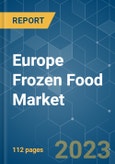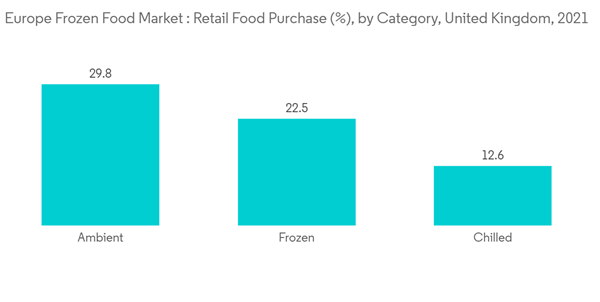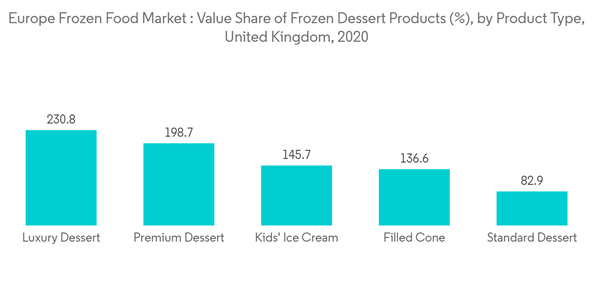The European frozen food market is projected to register a CAGR of 6.2% over the next five years.
The region has witnessed a growing demand for frozen foods in recent years, owing to the busy lifestyles, changing dietary habits, and increasing disposable income of households. The fast urbanization of certain countries, such as Germany, the Netherlands, and others, has increased the demand for convenience foods like frozen foods, as these can be prepared in less time and stored for a longer period. Additionally, the government's focus on reducing food waste is adding leverage to the frozen food market in some countries. According to a report by the European Commission, household food waste generated in 2020 averaged 31 kilograms per person, and 'out-of-home' food waste totaled 0.75 kilograms per person. Most of this waste is produced during the distribution and consumption phases. Because frozen goods have such a long shelf life, they naturally decrease waste across the supply chain, in stores, and at the consumer level.
Moreover, eco-conscious consumers in the region are also interested in new trends in the frozen food market, like clean-label and plant-based frozen foods, owing to the rising veganism in the country. This, in turn, has led the manufacturers to strategize their product offerings to include plant-based food items for the emerging vegan consumer base. In line with this, in April 2021, Aviko and Eurofrits launched a joint venture, namely, NeWind Foods in Spain, to incorporate the production of plant-based frozen food for domestic as well as international consumers.
This product will be delivered within 2 business days.
The region has witnessed a growing demand for frozen foods in recent years, owing to the busy lifestyles, changing dietary habits, and increasing disposable income of households. The fast urbanization of certain countries, such as Germany, the Netherlands, and others, has increased the demand for convenience foods like frozen foods, as these can be prepared in less time and stored for a longer period. Additionally, the government's focus on reducing food waste is adding leverage to the frozen food market in some countries. According to a report by the European Commission, household food waste generated in 2020 averaged 31 kilograms per person, and 'out-of-home' food waste totaled 0.75 kilograms per person. Most of this waste is produced during the distribution and consumption phases. Because frozen goods have such a long shelf life, they naturally decrease waste across the supply chain, in stores, and at the consumer level.
Moreover, eco-conscious consumers in the region are also interested in new trends in the frozen food market, like clean-label and plant-based frozen foods, owing to the rising veganism in the country. This, in turn, has led the manufacturers to strategize their product offerings to include plant-based food items for the emerging vegan consumer base. In line with this, in April 2021, Aviko and Eurofrits launched a joint venture, namely, NeWind Foods in Spain, to incorporate the production of plant-based frozen food for domestic as well as international consumers.
Europe Frozen Food Market Trends
Increasing Demand for Convenience Food
The busy lifestyle of European consumers is driving the demand for convenience food as they are looking for on-the-go snacks and meals in their daily diet. According to the statistics of the European Union, the accumulative share of the employed population involved in different types of work either from home or from different offices has witnessed an increase from 14.6% to 24.4% between 2019 and 2021. Further, due to the work pressure consumers are not able to invest their time in the preparation of food on daily basis, thereby, preferring frozen ready meals as it reduces the time to cook. Thus, working individuals demand ready-to-cook products like diced frozen vegetables and frozen pastes, making the cooking process convenient. Additionally, the demand for frozen snacks is also increasing, owing to their longer shelf life and easy storage properties. As a result, key brands are offering products in line with customer sentiments to gain a competitive advantage. For instance, in June 2021, McCain launched the Pickers range in the frozen appetizer category in France. The Pickers by McCain range includes products such as Mini Mozzarella Sticks, Crispy Onion Rings, Cheesy Italian Pops, and Nachos Cheese Triangles. Therefore, the convenience factor has influenced consumer preference for frozen food products. Thus, the aforesaid factors are expected to propel the market's growth.United Kingdom Dominates the Frozen Food Market in Europe
High consumer demand for frozen snacks, supported by the widespread availability of both private label and global brands across the distribution channels, is driving the growth of frozen food in the United Kingdom. In addition, families and younger consumers are opting for affordable, healthy options in the frozen food category with a longer shelf life. Further, the players in the market are focused on offering child-centric frozen food to expand their customer base. For instance, Ella's Kitchen, a leading baby food brand in the United Kingdom, offered its first-ever frozen food range for kids aged from weaning to three years. The products include toddler snacks and finger foods like sticks and puffs. Furthermore, growing health consciousness among consumers is anticipated to accelerate the demand for vegetarian and free-from foods like gluten-free, low-sodium, etc. Thus, companies are innovating new alternatives to cater to evolving consumer preferences. For instance, in December 2020, Aviko launched three new frozen potato products. The new frozen potato snack includes Super Crunch Julienne Fries, Bistro Garlic and Herb Wedges, and Mashed Potato. The company claims that these products are gluten-free and vegetarian-friendly.Europe Frozen Food Market Competitor Analysis
The frozen food market in Europe is highly competitive, with the presence of global as well as regional players. The existence of global players is boosting the competition for local operators in the region. Alongside this, the players are focused on sustaining their position in the market, focusing majorly on expanding their businesses and uplifting the brand image. To promote their respective businesses, these players are adopting product innovation and expansion as their key strategies. Some of these key players include General Mills Inc., Unilever Plc, Nestle SA, Tyson Foods Inc., and Nomad Foods Ltd, among others. The key players in the market are catering to both online and offline retail channels in order to expand their reach in the market. For instance, in May 2021, Iceland and The Food Warehouse launched a Del Monte Frozen Fruit range across offline stores and online platforms.Additional benefits of purchasing the report:
- The market estimate (ME) sheet in Excel format
- 3 months of analyst support
This product will be delivered within 2 business days.
Table of Contents
1 INTRODUCTION
4 MARKET DYNAMICS
5 MARKET SEGMENTATION
6 COMPETITIVE LANDSCAPE
Companies Mentioned (Partial List)
A selection of companies mentioned in this report includes, but is not limited to:
- General Mills Inc.
- Unilever
- Nestle SA
- Tyson Foods Inc.
- Nomad Foods Ltd
- Ajinomoto Co. Inc.
- Conagra Brands Inc.
- BEST FOOD S.C.
- Falken Trade GmbH
- FZ Foods AG
Methodology

LOADING...










